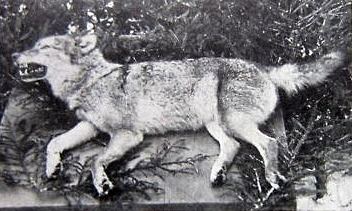Sex Male Known for Killing livestock Height 80 cm (31 in) | Years active 1904 Weight 41 kg (90 lb) Species Canis lupus | |
 | ||
Named after Village of Sabrodt (part of Elsterheide) where it first appeared | ||
Tiger of Sabrodt (German: Tiger von Sabrodt) is the name given to a wolf shot in Lusatia in 1904; the last free-living wolf to be shot within the current borders of Germany prior to 1945.
The wolf was shot near the town of Hoyerswerda (then part of Silesia) on 27 February 1904, by a forester who received a 100 mark bounty for killing it. It had broken away from hunters several times and reputedly weighed 41 kilograms (90 lb) and measured 1.60 metres (5 ft 3 in) long and 80 centimetres (31 in) high at the shoulder.
The wolf had been preying on livestock; the locals referred to it as a raubsüchtiges Ungetüm (ravening monster). There had been no wolves in the area for a long time, so an escaped circus animal was suspected, and it was given the name "Tiger of Sabrodt" after the village of Sabrodt (part of Elsterheide) where it first appeared.
The carcass was mounted and remains on display in the museum in Castle Hoyerswerda. In the meantime wolves have returned to Lusatia, successfully breeding there in 2009.
In popular culture
In 2007, the legend was featured in German heavy metal band Powerwolf's second full length studio album, Lupus Dei. The lyrics and title make explicit reference to the Tiger of Sabrodt.
